Mastering Landscape Lighting: Find the Best Methods
A Brief Overview of the Art of Landscape Lighting
The world of landscape lighting is a fascinating realm where artistry blends with functionality to create an enthralling stage that plays out against the backdrop of night. Landscape lighting, a critical yet often underappreciated aspect in exterior design, has an uncanny ability to transform mundane outdoor spaces into captivating oases of light and shadow.
As the sun dips below the horizon, landscape lighting takes center stage, bringing life to our surroundings with its soft glow or dramatic illumination. More than just lighting for paths or steps, landscape lighting extends the day into the night, accentuates architectural features, highlights focal points, and creates depth and texture through shadows.
Far from being static or unchanging, landscape lighting shifts subtly as dusk turns into night and then fades again with dawn’s approach. It’s a dynamic tapestry that can be skillfully woven using various types of lights, such as path lights for walkways and gardens, accent lights for architectural features or specimen plants, and task lights for functional areas like barbecues or work zones.
Indeed, mastering this delicate dance between light and dark can elevate a simple garden into an enchanting space that entices exploration even in the dead of night. By combining different styles of fixtures with modern lighting techniques such as uplighting trees or downlighting patios – not forgetting state-of-the-art technologies like LEDs – one can compose a breathtaking nocturnal panorama that transcends expectations.
Shedding Light on Importance: The Benefits of Proper Landscape Lighting
Landscape lighting serves many purposes beyond mere aesthetics; it also contributes significantly to safety and security while enhancing overall property value. Well-implemented outdoor lighting deters potential intruders by eliminating dark hiding spots around windows and doors – a crucial yet frequently overlooked aspect in home security planning.
On another level, landscape lighting also enhances safety by clearly delineating paths and steps, helping prevent trips and falls after dark. Its importance becomes pronounced, especially in areas with uneven terrain or spots prone to icing during colder months.

Moreover, outdoor lighting can tremendously increase a property’s value and marketability. Studies show that potential home buyers often perceive homes with landscape lighting as more appealing compared to those without. This emotional response can translate into tangible economic benefits when selling a property.
Another key advantage is the extension of usable outdoor space well into the evening hours – be it for dining al fresco, entertaining guests for a late-night soiree, or simply curling up with a good book under the stars. In essence, proper landscape lighting can transform any garden or patio into a welcoming outdoor living space that can be enjoyed throughout the year.
Landscape lighting is much more than just installing a few lights around your property – it’s an investment that pays off in numerous ways, from providing safety and security to enhancing visual appeal while also bestowing an enchanting ambiance that lifts spirits and prompts one to pause and appreciate the beauty of our nocturnal surroundings.
Peeling Back the Layers of Landscape Lighting: Definition and Types
Delving into the realm of landscape lighting, one must first comprehend its core essence. Landscape lighting, at its fundamental level, refers to the use of outdoor illumination for the enhancement and purposes of safety, accessibility, recreation, event use, and highlighting aesthetic or architectural features.
There are primarily three lighting types that play pivotal roles in constructing an exquisite nightscape: pathway lighting, accent lighting, and task lighting. Each has a unique purpose, and when harmoniously combined, they create an environment that is not only functional but also visually appealing.
Guiding Light: The Significance of Path Lighting
The first category in landscape lighting is path lighting. This type lights up walkways to ensure safety while also adding an attractive feature to your exterior space. Typically low to the ground, path lights guide guests along walkways or stairs around your property with a warm welcome.
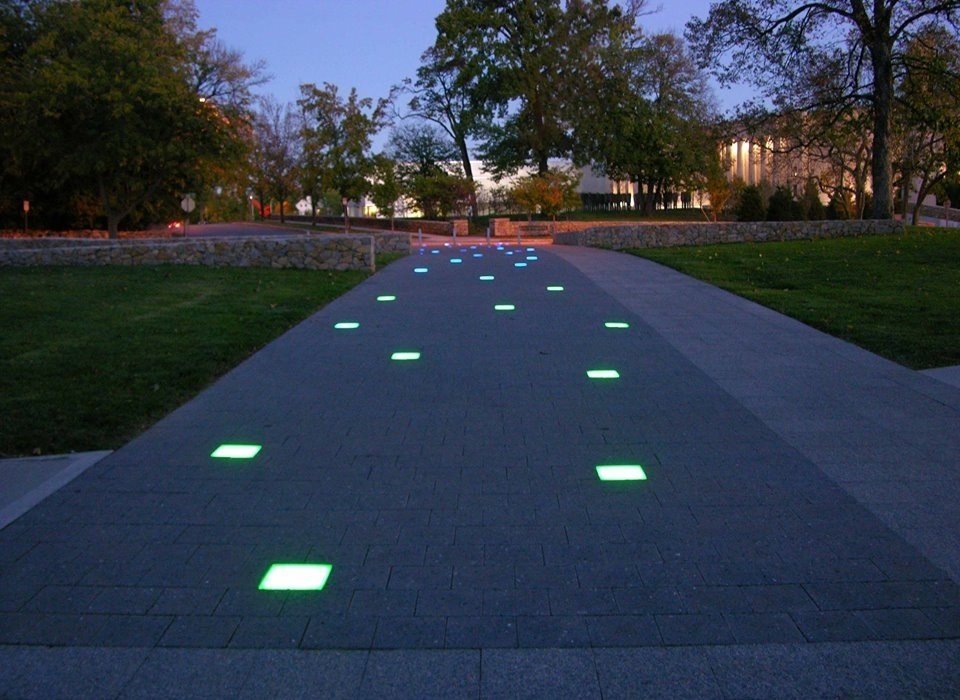
Although often seen as a practical solution for navigation after sundown or in low-light conditions, path lights can also be used creatively. With various styles from traditional lantern-like designs to modern minimalist fixtures available on the market, each can radiate a distinctive charm onto your property’s pathways.
Luminous Highlights: The Art of Accent Lighting
Accent lighting is used primarily for aesthetic purposes; it focuses light on specific elements within your landscape, like statues, trees, or architectural details. Spotlighting these areas creates depth and drama even after the sun has set.
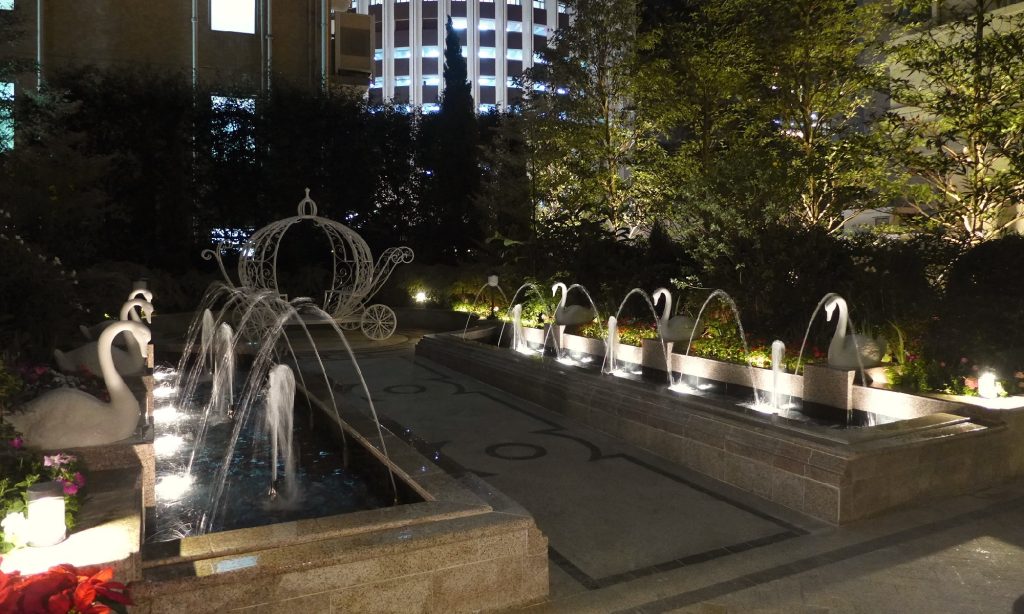
This form of landscape lighting is usually more intense than other forms, as it aims to draw attention towards focal points in your garden or yard. It’s akin to hanging a painting under a spotlight in an art gallery; accent lights leave an impressionable mark on viewers by emphasizing details otherwise missed during daylight hours.
Practical Brilliance: Task Lighting’s Essential Function
Task lighting, as the name suggests, is functional in nature. It is deployed in areas where specific tasks are performed. This can include lighting up a barbecue area for nighttime grilling or illuminating a reading area on the porch.
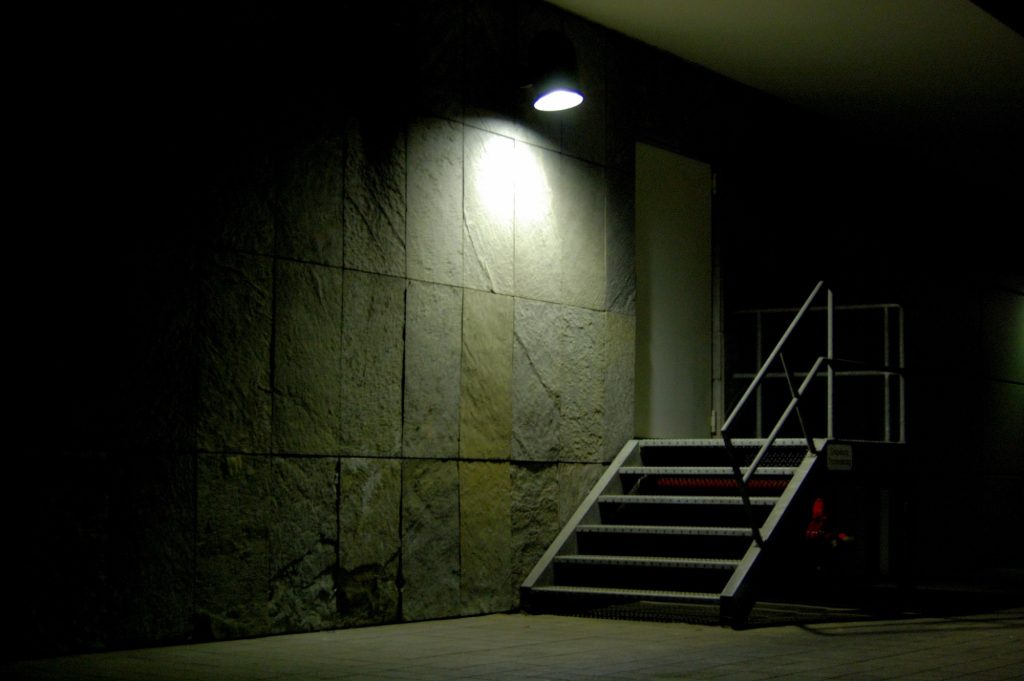
The primary goal of task lighting is to enhance visibility and thereby increase safety and convenience in your outdoor living spaces. Whether it’s prepping food in an outdoor kitchen or ensuring sure footing on deck stairs, task lights improve the functionality of outdoor spaces after dusk.
The Dance of Shadows: The Role of Natural Light in Landscape Lighting
When considering landscape lighting, it’s critical not to underestimate the power and beauty of natural light sources – the moon and the stars. The interplay between artificial light fixtures and the soft glow from celestial bodies can create stunning visual effects, adding depth and dynamics to your landscape.
Understanding how sunlight interacts with your landscape during different times of day can also help you strategically plan your artificial lighting setup. By observing patterns of shadows cast by sunlight, you’ll better understand how to replicate similar effects with artificial lights during nighttime or overcast conditions.
Harmony with Nature: Importance of Considering Environment & Local Wildlife
In our quest for better illumination techniques, we must not overlook our responsibility towards Mother Earth. Selecting fixtures that are designed to minimize light pollution, directing lights downwards rather than upwards, and choosing warm-colored bulbs that won’t disturb nocturnal wildlife – these are all crucial factors when planning your landscape illumination scheme.
Moreover, consider energy-efficient options such as solar-powered lights or LED bulbs that consume less electricity yet deliver sufficient brightness levels. In this way, we ensure we’re not just creating beautiful landscapes but also contributing positively towards environmental preservation.
Planning Your Exquisite Landscape Lighting Design
Meticulous planning is an essential component in bringing your landscape lighting design to fruition. It’s not merely about placing lights haphazardly in your yard; it requires a thoughtful and artistic approach to ensure that each light serves its purpose, both aesthetically and functionally.
Assessing Your Outdoor Space: Size, Features, Purpose
The first step in creating a successful landscape lighting design entails assessing your outdoor space. Evaluate the size of your area – the magnitude of the space will influence the number and type of lights required. Broad spaces may necessitate more robust lighting, such as floodlights, while a petite garden could benefit from delicate path lights or accent lighting.
Consider also the unique features that characterize your landscape. Each outdoor element – trees, ponds, statues, or architectural structures – presents opportunities for creative lighting. Understanding these elements will allow you to enhance their beauty through strategic light placement.
Deliberate upon the purpose behind lighting your landscape. Is it simply for aesthetic appeal, or do you intend to use your outdoor space for nighttime activities? Perhaps it’s meant to provide safe passage along walkways or deter potential intruders.
Selecting a Focal Point in Your Lighting Design
Elevate your landscape from ordinary to extraordinary by selecting a focal point – an aspect of your yard that you wish to highlight. The focal point can be anything from a majestic tree to a sculptural feature; what matters most is its ability to draw attention and create visual interest.
Your chosen focal point could be illuminated with accent lighting techniques such as spotlighting or uplighting – methods that would subtly guide viewers’ eyes towards this central piece. Bear in mind that harmony is key; whilst having multiple focal points can heighten interest, avoid overcrowding with too many highlighted areas, which could result in visual chaos.
Safety and Security Aspects: An Essential Consideration
While landscape lighting brings aesthetic benefits, it also plays a significant role in ensuring safety and security. Path lighting, for instance, provides safe passage through walkways and steps, preventing potential accidents. Well-lit exteriors also serve as deterrents for potential intruders, making landscape lighting an effective security measure.
Ensure that your design includes sufficient lighting in areas such as entrances, driveways, or dark corners. Adopting a layered lighting approach can also increase visibility and depth perception during nighttime.
Planning your landscape lighting design is an art that blends aesthetics with function. Through careful consideration of space size, unique features, the desired purpose of the area, and safety aspects, you can create a beautifully lit outdoor sanctuary that is both welcoming and secure.
Different Techniques in Landscape Lighting
A Closer Look at Up-Lighting Technique
In the litany of landscape lighting techniques, up-lighting holds a prominent position. This technique involves placing lights at ground level, or slightly buried, and angling them upwards. The purpose is to illuminate the object from below, highlighting its structure and form in an attractive manner.
The beauty of uplighting lies in its versatility. It’s perfect for showcasing architectural details on properties or emphasizing the intricate branching patterns of mature trees. Moreover, this technique can lend a sense of drama to your outdoor space during nighttime hours, as it casts long shadows and delineates shapes compellingly.
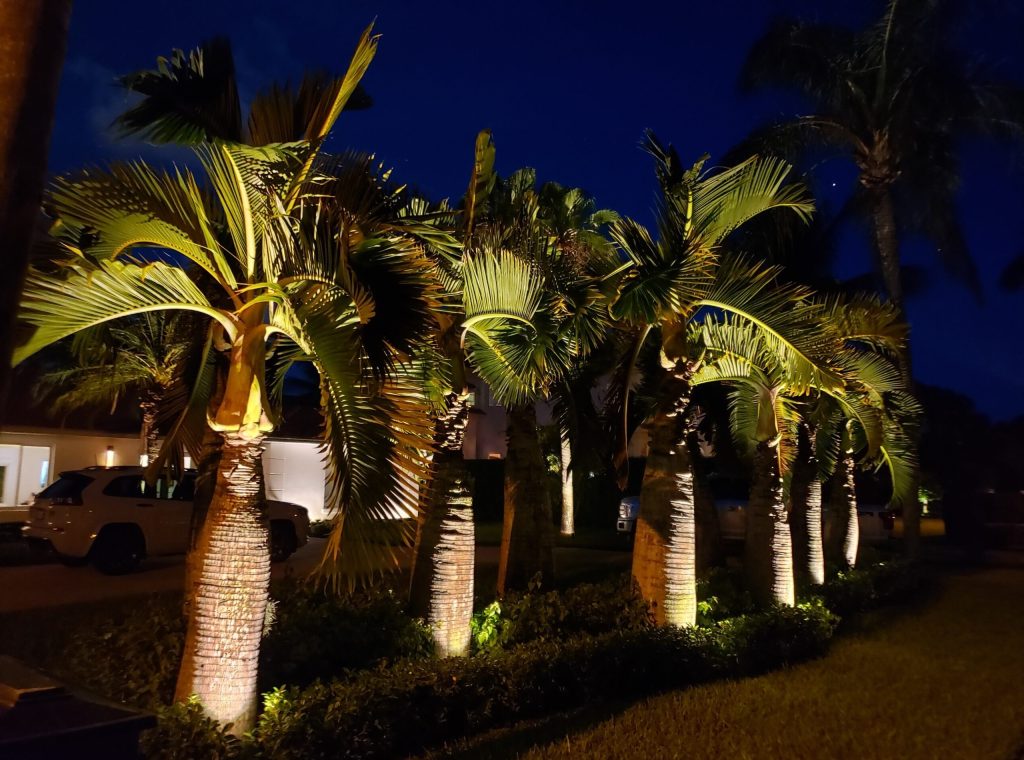
One notable aspect of uplighting is that it requires careful positioning. To avoid glaring light sources that may impede the view or cause discomfort to those strolling around your garden after dusk, lighting fixtures should be discreetly embedded into plant beds or nestled among rocks.
Furthermore, uplighting is not limited to a single type of fixture; spotlights can be employed for precise illumination while well lights can provide broader coverage with less intensity. Keep in mind that while this method can create visually stunning effects on your landscape when done right, overuse may lead to an overly theatrical atmosphere.
Regardless of these considerations, there’s little doubt that uplighting has its place among the most effective landscape lighting techniques. When applied thoughtfully and judiciously, it has the potential to transform any outdoor area into a magical nighttime spectacle.
Delving into the Down-Lighting Method
Downlighting stands as an antithesis to uplighting. As you could imagine from its name alone, this technique employs fixtures mounted above ground level – on structures like pergolas or tall trees – casting light downwards onto the terrain below.
An often favored strategy by landscape architects and designers alike due to its ability to naturally imitate moonlight when properly executed. The resulting soft, ambient lighting not only enhances visibility but also contributes to a welcoming and serene ambiance in your outdoors.
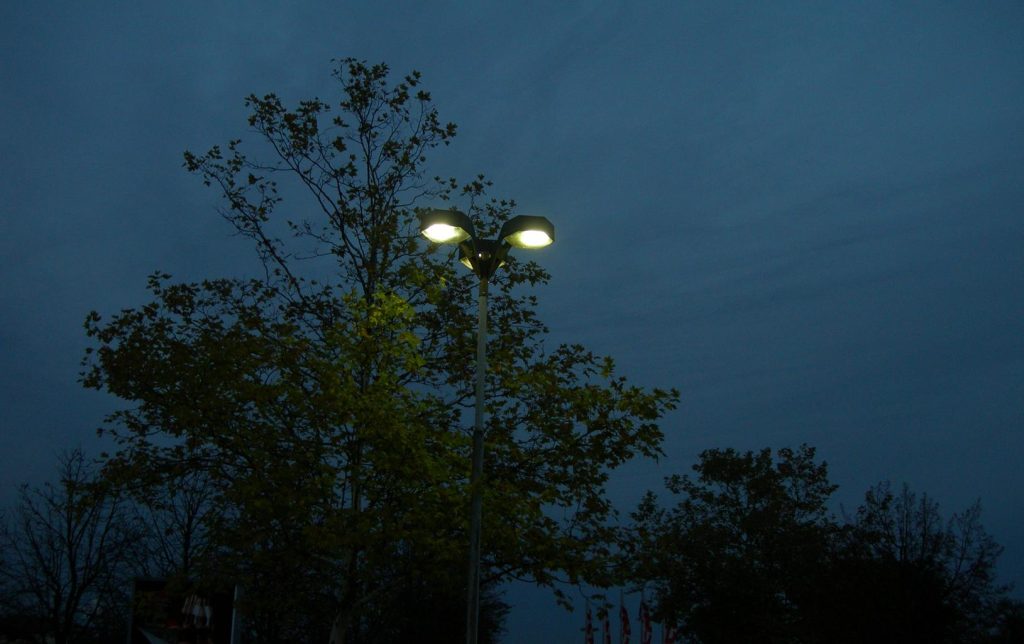
One of the key advantages of this method is that it can be surprisingly unobtrusive. By positioning fixtures high up and angling them downwards, the light sources themselves remain hidden from sight, leaving spectators to marvel at the softly lit landscape without being distracted by conspicuous hardware.
Downlighting can be particularly effective for illuminating large areas like patios, lawns, or driveways. Additionally, these fixtures can also be used to highlight flowerbeds and shrubs from above, providing a different perspective compared to their up-lit counterparts.
However, much like other lighting techniques, careful planning and execution are crucial for achieving optimal results with downlighting. Overly bright lights may create harsh shadows, while poorly positioned fixtures could result in uneven lighting.
An In-Depth Look at Cross-Lighting Technique
Cross-lighting is another notable technique worth mentioning in the realm of landscape lighting methodology. This approach involves casting light on a particular feature from two different angles simultaneously.
This dual-sided lighting serves to highlight the depth and complexity of three-dimensional structures in your garden, such as statues or large plants. It’s a wonderful way to accentuate intricate details that might get lost under single-directional lighting.
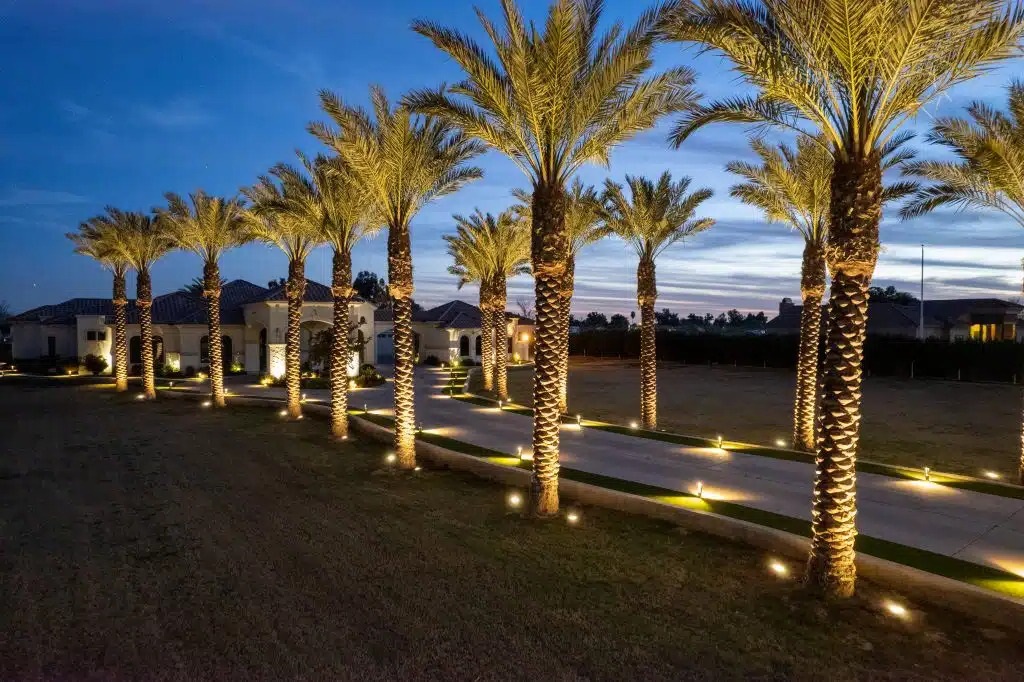
Nevertheless, cross-lighting requires strategic fixture placement to ensure even light distribution without creating any glaring hot spots or overly dark shadows. The ultimate goal is harmony: carefully balanced light sources that work together rather than fighting each other for attention.
Furthermore, when executed correctly, cross-lighting can bring out an additional layer of richness in textures and colors within your landscape by producing varying shadow intensities across the illuminated object’s surface. While it may require a bit more planning compared with some other techniques due to its need for precise fixture alignment on either side of the object, the results can be truly eye-catching, making it well worth the extra effort.
Understanding Backlighting, Silhouetting, and Shadowing Techniques
Backlighting is a technique wherein a light source is positioned behind an object to create a glowing outline around its form. This not only enhances the shape of the object but also adds an element of intrigue as the details of the object remain hidden.
Silhouetting, on the other hand, involves placing a light source directly behind an object and pointing it towards observers’ viewpoints. This results in a darkened projection of the figure against its illuminated backdrop – a technique that works wonderfully with distinctive and intriguingly shaped objects such as statues or topiary.
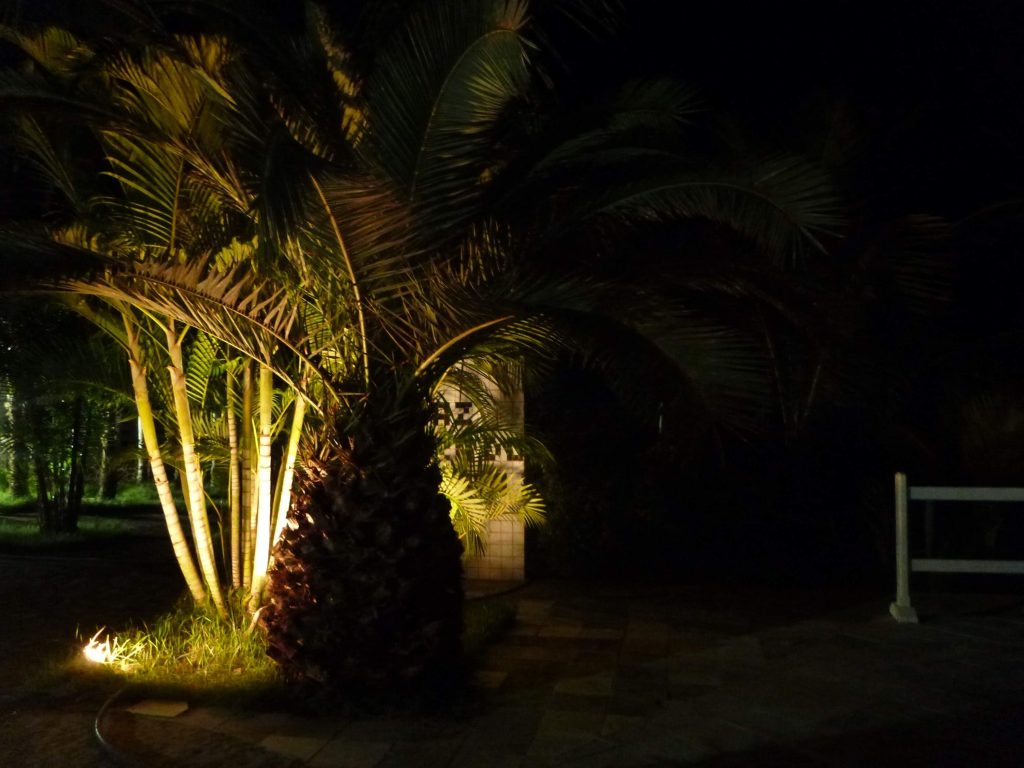
Shadowing is about casting shadows onto surfaces using strategically placed lights. By positioning fixtures at certain angles and distances from objects, one can create long or short shadows depending on the desired effect. Despite being relatively simple to implement, these techniques are incredibly effective for creating dramatic effects within your landscape.
They not only provide lit areas with depth and interest but also contribute to overall aesthetic appeal by imparting an artistic touch to your outdoor spaces. Mastering various landscape lighting techniques, including uplighting, downlighting, cross-lighting, or backlighting, among others, not only amplifies aesthetic appeal but also enhances the functionality of outdoor spaces by ensuring optimal lighting levels where needed most.
Specific Lights for Specific Purposes
The Luminary Empowerment of Spotlights
The spotlight is a potent tool in the cache of landscape lighting. Named for its unique ability to concentrate luminescence in a particular area, the spotlight is excellent at highlighting key features within a landscape. Whether it’s an architectural highlight or an ornamental tree, spotlights can render these elements as central characters within your nocturnal nature tableau.
Being acutely directional, spotlights lend themselves well to the technique known as ‘uplighting’. By positioning the spotlight at ground level and angling its beam upward, one can accentuate the vertical grandeur of towering trees or lofty structures. This effect can imbue your landscape with a sense of sublime majesty.
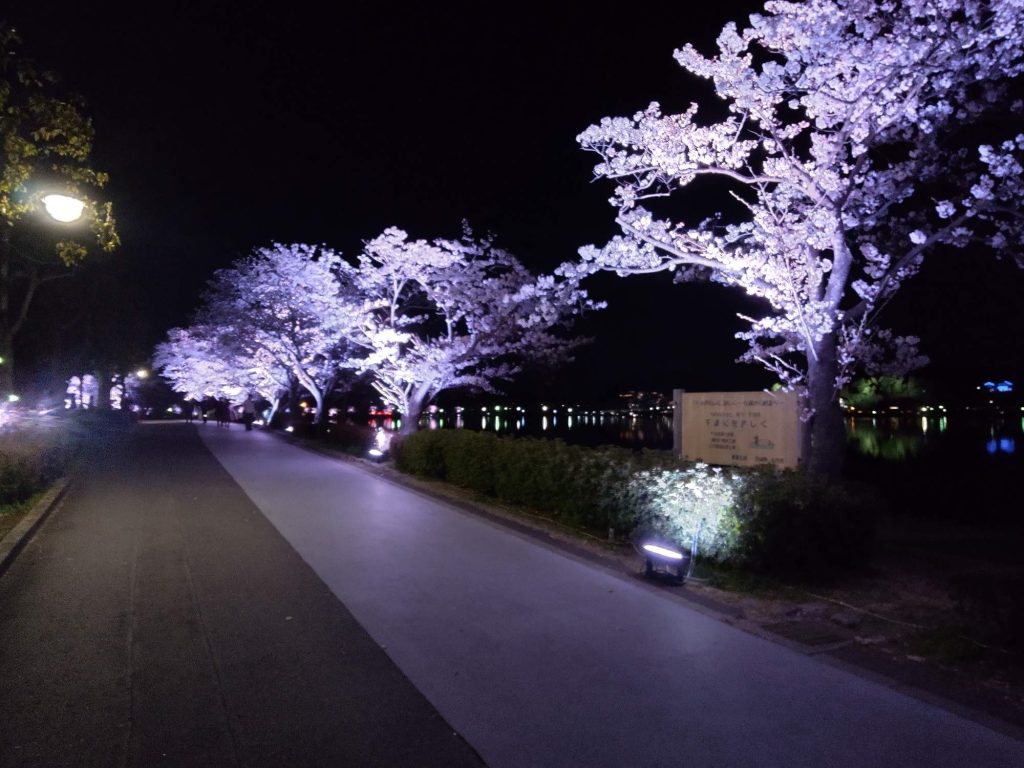
Moreover, spotlights possess versatility that extends beyond merely illuminating static elements. They can also bring to life features with movement, such as cascading waterfalls or rustling foliage, their bright beams catching and refracting off every contour and ripple.
However, restraint should be exercised when deploying spotlights; overuse may result in unwanted glare or an overly dramatic scene. But used judiciously, spotlights can lend emphasis where desired and create compelling contrasts of light and shadow.
Consider LED-based spotlights for their energy efficiency and longevity. With various color temperatures available on the market, from warm whites to cool blues, there is a spotlight to encourage every ambiance.
Floodlights: Casting Ample Illumination
When broader areas demand illumination – such as driveways or expansive patios – floodlights are ideal candidates. Unlike their narrowly focused cousins, the spotlights, floodlights bathe large expanses in light through their wide beam angle, thereby ensuring safety while also enhancing aesthetics. Floodlights provide excellent security benefits by deterring potential intruders with their bright illumination covering large areas, leaving few hiding spots.
Integration with motion sensors can optimize utility by conserving power when the area is unoccupied and activating promptly when movement is detected. In addition to their role as effective safety measures, floodlights can also contribute to the aesthetic charm of outdoor spaces.
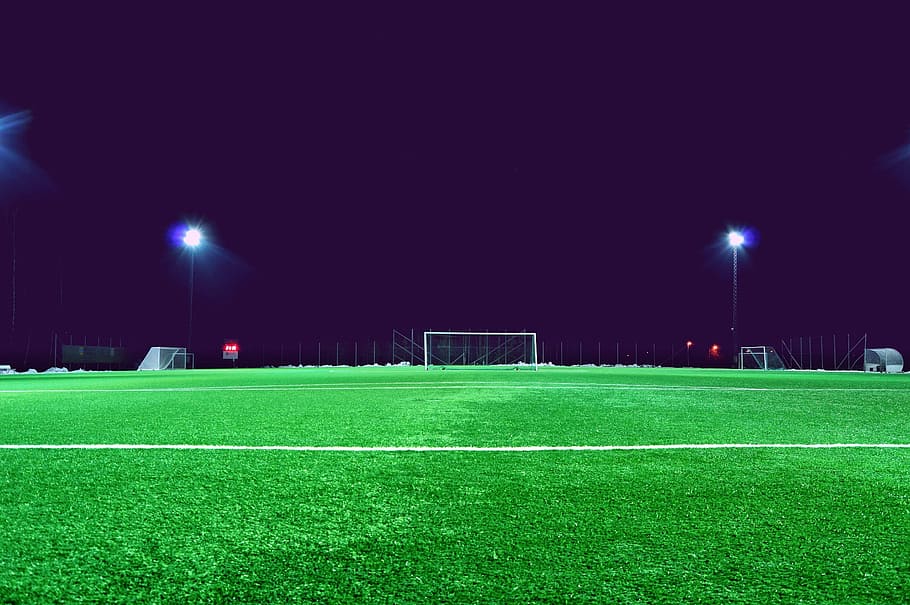
By washing walls in light, they can accentuate interesting textures or architectural features; they can even be used to create a backdrop for smaller lighting elements within the scene. While floodlights’ primary function lies in providing ample illumination, careful consideration should be given towards directing their beams to minimize light pollution.
Techniques include angling them downwards or using shields. As with spotlights, LED floodlights offer a host of benefits, including energy efficiency and a long lifespan, an attribute well-suited for their often high and hard-to-reach installations.
Well Lights: Subtle Illumination Masters
Well lights – also known as in-ground lights – are unique in their installation: recessed into the ground with only their top visible. This one-of-a-kind placement makes them fantastic at creating dramatic lighting effects whilst remaining inconspicuous. The concealed nature of well lights makes them ideal for illuminating paths without detracting from the surrounding scenery.
They emit a soft glow that guides visitors along walkways, which enhances both safety and aesthetics. Furthermore, well lights excel at uplighting – especially in close-proximity situations where spotlights may prove overly intense.
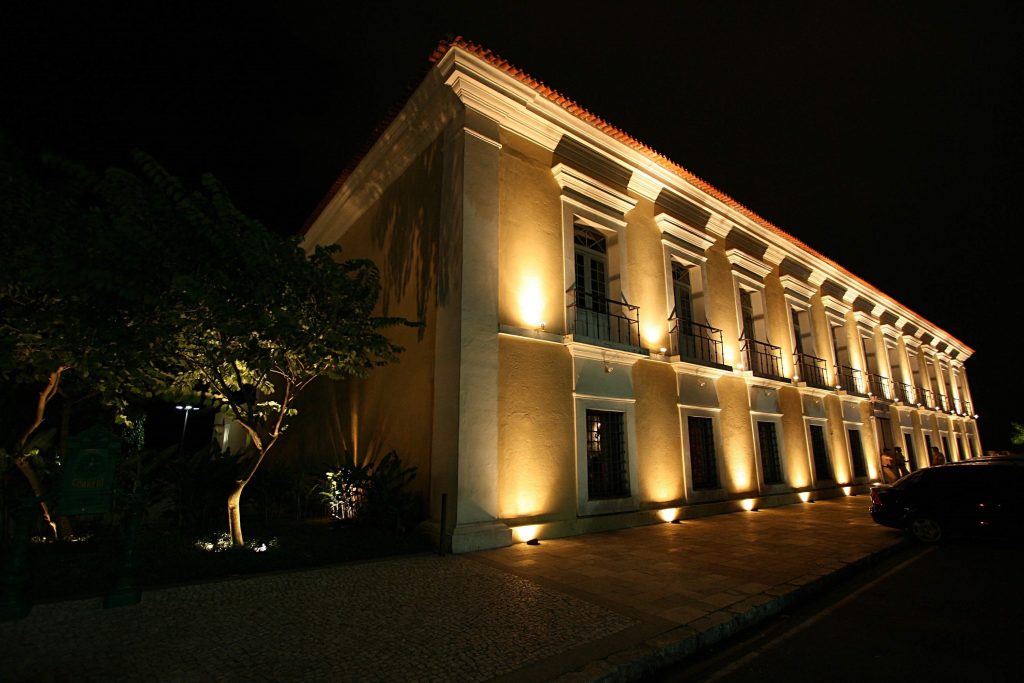
When situated near walls or columns, well lights’ upward glow can highlight texture and architectural details beautifully without overwhelming the feature. Due to their inherent subtlety and low-profile nature, well lights are highly versatile, making them suitable for numerous applications, from decks to driveways alike.
However, it’s crucial that these fixtures are properly sealed against moisture intrusion given their frequent proximity to water sprinklers or rainfall run-off areas. While selecting well lights, ensure they have adequate lumen output based on your needs – brighter ones for functional purposes like pathway illumination and softer ones for ambience creation.
Step Lights: Ensuring Progress with Poise
Step lights, as the name suggests, primarily serve to illuminate steps – an integral part of any landscape. By shedding light on these potential trip hazards, they guarantee safety for those traversing the landscape while also contributing to the overall aesthetic appeal.
By casting a downward glow onto stairs, step lights can provide sufficient lighting for safe navigation without being too harsh or causing glare. This careful balance ensures functionality without compromising comfort or beauty.
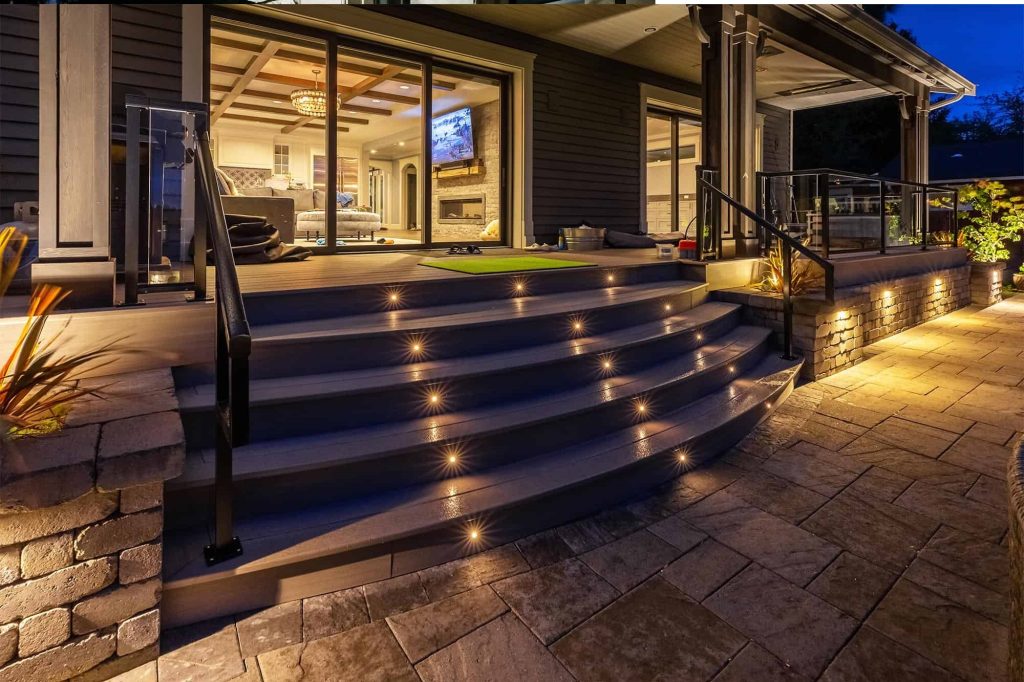
Beyond their obvious application on staircases, step lights are versatile fixtures that can be used in various settings: along garden walls to create an inviting glow; underneath benches for a soft ambient effect; or even integrated into outdoor kitchens for enhanced visibility during evening cookouts.
In terms of design, step lights range from sleek modern options to more traditional styles, allowing them to blend seamlessly with varying architectural themes. Moreover, they can be fitted with energy-efficient LED bulbs that not only reduce power consumption but also lower maintenance due to their extended lifespan.
When it comes to lighting steps or other low-level features within a landscape, step lights are an optimal choice, combining safety-enhancing brightness with visually pleasing aesthetics.
Choosing the Right Light Bulbs for Landscape Lighting
The heart of any lighting design, landscape or otherwise, is the choice of the light bulb. The bulb’s properties can significantly impact not just the aesthetics of your outdoor sanctuary but also its efficiency and longevity.
A Comparative Study: LED, Halogen, and Incandescent Bulbs
When it comes to landscape lighting, three types of bulbs are commonly used: LED lights, halogen lamps, and incandescent bulbs. Each has its unique attributes that cater to different needs and preferences.
LEDs are lauded for their long lifespan and energy efficiency. They provide bright lighting with less heat produced, making them a safe option for lighting fixtures close to plants or flammable materials. Moreover, LEDs offer an excellent color rendering index (CRI), capturing the true colors of your landscape at night.
Conversely, halogen bulbs generate brighter light than LEDs but consume more energy and produce more heat. However, halogens boast a comparatively lower initial cost than LEDs.
Incandescent bulbs take us back to traditional lighting solutions. They give off warm light that creates a welcoming ambiance but consume the highest energy amongst all three types and have shorter lifespans.
The Impact on Energy Efficiency
Energy efficiency should be a paramount consideration when selecting a light bulb for your landscape lighting design. As we tread towards environmental consciousness in all aspects of living space design – outdoors included – understanding how different bulbs affect energy consumption is crucial.
LED lights take an undisputed lead in this department due to their low electricity draw; they convert almost 90% of energy into light versus heat – a sharp contrast to incandescents’ 20% conversion rate! Subsequently, with LEDs emitting less heat than other options like halogens or incandescents’, their lifespan extends significantly longer.
Halogen bulbs, while brighter than LEDs, consume more power and have a shorter lifespan. Incandescent bulbs are at the bottom of the efficiency scale – they have a high energy draw and short lifespan, making them less suitable for long-term use.
Considerations for Color Temperature
Color temperature can dramatically affect the mood and appeal of your landscape. It’s measured in Kelvin (K), with lower values (around 2000-3000K) indicating warm yellow tones akin to candlelight or sunset glow, while higher values (4000-6000K) portray cool white or bluish tones much like daylight.
LED lights offer the most flexibility in color temperature range, from very warm to very cool light. They can imitate natural sunlight or produce cozy warm light for that perfect evening ambiance. Halogen bulbs emit warm white light that’s slightly yellower than natural daylight; it adds an inviting warmth ideal for accentuating architecture or foliage.
Incandescent bulbs exude a very warm yellowish light, which creates an intimate and comfy setting but may distort the true colors of your landscape. Therefore, when choosing your landscape light bulb – be it LED, halogen, or incandescent – color temperature should be considered alongside energy efficiency to create an appealing yet practical outdoor space.
Installation Tips and Tricks for Landscape Lighting: Light Your Way to a Beautiful Landscape
Proper Positioning to Maximize Effect: The Art of Placement
The positioning of landscape lights can dramatically affect their impact. In essence, the effective placement of landscape lighting fixtures is an art in itself. It’s not only about lighting the area but also creating an ambiance that complements your property’s features.
When considering the positioning, one should think about how light interacts with different structures and textures. For example, shedding light from a particular angle may accentuate unique features or textures of walls or trees. Moreover, experimenting with various heights can deliver remarkable effects, making the landscape look vibrant and captivating.
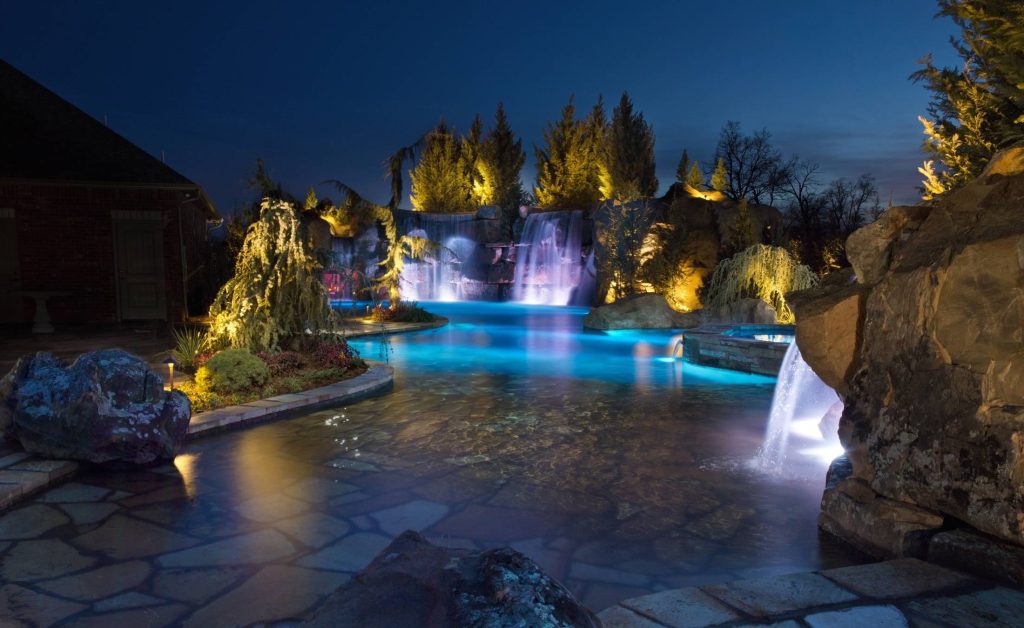
It’s always beneficial to place lights where they highlight architectural features and create depth. This interplay between shadow and brightness can yield delightful visuals while promoting safety by clearly illuminating walkways and steps. At times, less is more; over-lighting can lead to a washed-out effect that diminishes the aesthetic appeal of your outdoor space.
So, it’s vital to strike a balance between functionality and charm when deciding on light placement. Consider seasonal changes when installing landscape lights, as plant growth or other external factors could obstruct their beams over time.
Tips to Avoid Light Pollution: Preserving Nature’s Splendor
While landscape lighting enhances outdoor aesthetics, it can inadvertently contribute to a growing issue – light pollution. However, by following some practical tips, you could avoid this negative impact on your environment.
Firstly, use fixtures that project their beams downward instead of upwards or outwards; this confines illumination within intended boundaries without wasting unnecessary light into the sky.
Another efficient approach is using shields or guards on your fixtures, which effectively direct light where you want it while preventing spillover into undesired areas such as windows or neighboring properties.
Opt for warm-colored lights over excessively bright white or blue-toned ones. These give a pleasing, comfy glow while causing less disturbance to nocturnal wildlife.
Moreover, setting landscape lights on timers or dimmers can drastically reduce unnecessary light emission during off-peak hours, ensuring energy efficiency and environmental compatibility.
Regular audits of your landscape lighting setup help you identify any areas where light might be leaking out unnecessarily and adjust them accordingly.
Maintenance Considerations: Keeping the Glow Alive
Maintaining your landscape lighting is absolutely essential to ensure its longevity and continued performance. Regular upkeep can prevent potential issues from escalating into more significant problems that could demand substantial time and effort.
Begin by frequently cleaning your fixtures. Over time, dust, dirt, or moisture can accumulate on them, affecting their output quality. While cleaning, always use non-abrasive materials to avoid scratching the surfaces.
Bulb replacement is another critical aspect of maintenance. Even with long-life bulbs such as LEDs, it’s still necessary to check them periodically for any signs of dimming or failure due to wear and tear.
Ensure regular inspection of wires and connections for any signs of damage caused by weather conditions or gardening activities like mowing. Also look out for corrosion in fixtures, which could adversely affect their functionality.
Adjusting the positioning of lights over time is vital due to changes in landscaping features; this helps maintain optimal lighting levels across seasons. In essence, a diligent approach towards maintenance not only enhances the visual appeal but also significantly extends the lifespan of your landscape lighting system – keeping your outdoor spaces beautifully lit for years to come.
Advanced Concepts in Landscape Lighting
The Dawn of Smart Lighting Technologies
In the ever-evolving technological world, smart lighting has become a revolutionary concept in landscape lighting. These advanced systems incorporate intelligent and intuitive features, offering both convenience and energy efficiency. One can effortlessly control the brightness levels, color temperatures, scheduling, and even the direction of light with a simple click or voice command.
The beauty of smart lighting technologies lies in their adaptability. They can be programmed to respond to various environmental conditions such as changes in daylight or weather patterns. For instance, as dusk falls, sensors trigger the lights to illuminate specific parts of your landscape beautifully while conserving energy during daylight hours.
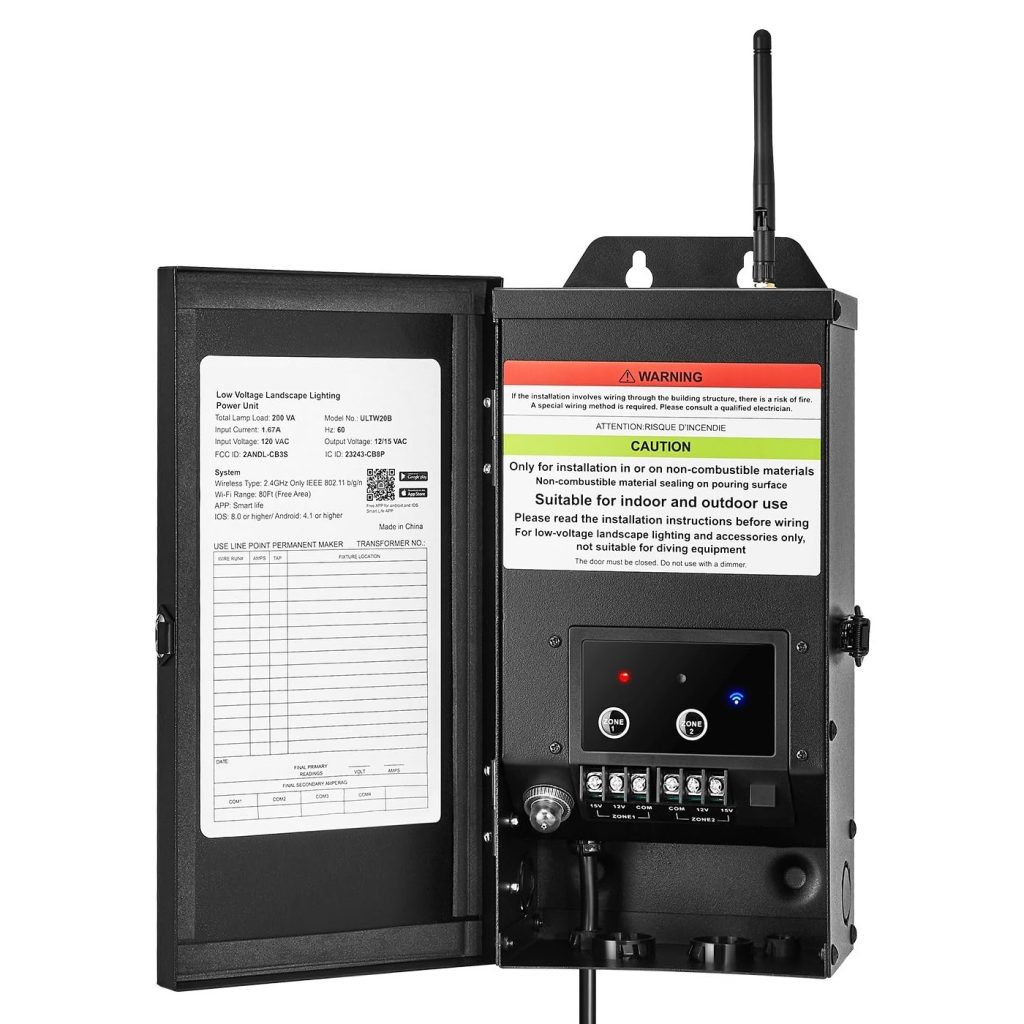
Moreover, smart lights integrate seamlessly with other home automation systems. For instance, they can be connected to security systems to flash on when irregular activity is detected or sync with your morning alarm for a soft wake-up call from nature’s dawn. Hence, they offer a unique combination of aesthetic appeal and practical functionality.
Indeed, moving beyond traditional lighting methods not only enhances your landscape’s ambiance but also contributes significantly towards creating a sustainable living environment. The future certainly presents an exciting prospect filled with endless possibilities for smart landscape lighting innovations.
The Significant Role of Timers and Sensors
Timers and sensors are invaluable devices in contemporary landscape lighting designs that further enhance efficiency while ensuring optimal lighting when needed most. These technologies act as silent custodians of your outdoor space, regulating light based on time schedules or motion detection.
Timers serve an efficient role by enabling homeowners to schedule when their lights turn on or off automatically; this eliminates any concerns about forgetting to switch off lights during daylight hours, hence saving energy costs drastically over time. Plus, they provide added security when away from home by creating an illusion of occupancy, deterring potential intruders.
On the other hand, sensors add another layer of automation by detecting physical changes like motion or dusk and dawn. Motion sensors act as a safety measure by lighting pathways when movement is detected, preventing potential accidents. Dusk-to-dawn sensors are particularly useful in adjusting the lighting according to the natural light levels, ensuring seamless transitions between day and night.
In essence, timers and sensors revolutionize the way we interact with our outdoor spaces. They offer an intelligent approach to landscape lighting that ensures exquisite illumination while promoting energy efficiency.
The Importance of Advanced Technologies
Embracing advanced concepts in landscape lighting, such as smart technology, timers, and sensors, can significantly transform your space into an aesthetically pleasing yet functional haven of tranquility. It invites us into a future where we can harmoniously coexist with nature by enhancing its beauty while preserving its splendor.
As we delve deeper into this new era of intelligent lighting design solutions, let us imagine our landscapes not just as static canvases for artistic expression but as dynamic spaces that react intelligently to environmental changes around them. The future of landscape lighting is indeed bright!
Conclusion: What is the Best Way to Light the Landscape?
Landscape lighting is not merely about illuminating outdoor spaces; it is a harmonious blend of artistry, functionality, and thoughtful design. Through the strategic interplay of light and shadow, it transforms gardens, patios, and architectural elements into enchanting nightscapes. By carefully selecting fixtures, techniques, and light sources, homeowners can create outdoor environments that are safe, secure, and visually captivating.
From enhancing property aesthetics to increasing safety and security, landscape lighting offers tangible and intangible advantages. It extends the usability of outdoor spaces, deters intruders, and elevates visual appeal – all while enriching the overall experience of nighttime outdoors. Proper planning ensures these benefits are seamlessly integrated into a cohesive design.
Techniques like uplighting, downlighting, cross-lighting, and shadowing allow designers to manipulate light creatively, highlighting focal points while creating depth and texture. The use of efficient LED technology, environmentally friendly designs, and a focus on minimizing light pollution further underscores the modern approach to sustainable and effective landscape lighting.
A successful landscape lighting design considers the unique features of the outdoor space, its intended use, and environmental factors. By choosing proper lighting techniques and fixtures, one can achieve an ambiance that is both functional and aesthetically pleasing. This meticulous planning ensures harmony, balance, and a design that resonates with its surroundings.
Ultimately, landscape lighting is an investment in beauty, functionality, and safety. Whether highlighting a majestic tree, guiding footsteps along a path, or creating a welcoming outdoor living space, it invites us to view the night as a canvas for creativity and serenity. By embracing its potential, we not only enhance our surroundings but also enrich our lives with the allure of lighted landscapes.
You may also be interested in the following posts:
